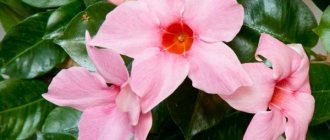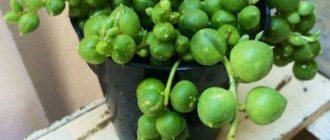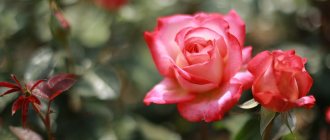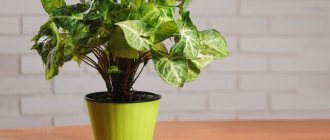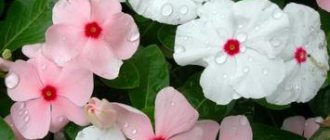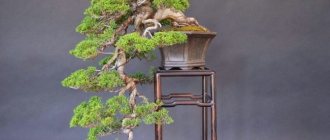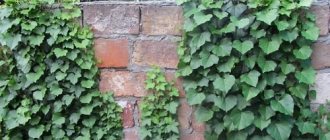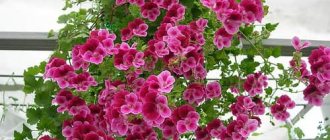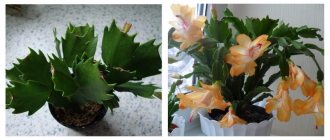Dipladenia (its other name is mandevilla) is a climbing perennial vine from the Kurtov family.
At home in Argentina, it grows to a height of five meters, but with proper care and timely pruning at home, its growth can be limited to one meter.
At the same time, more than 45 large tubular inflorescences with a pleasant aroma can open on the vine.
Dipladenia is a flower with extremely rapid growth; in a year it can gain half a meter in length.
Mandevilla-dipladenia - the queen of indoor vines
Diplademia is also known as mandevilla. This happened because they were simultaneously and independently discovered by two different scientists. At first it was believed that these were two different plants, then the confusion was sorted out and they were combined into one genus, but this plant still has two names.
Dipladenia at home
This ornamental plant belongs to the Kutrov family. Central and South America are considered its homeland. More than 40 species of mandevilla are known. Depending on the growing conditions, Dipladenia can grow into a flowering bush or become a decorative branching vine.
The stems of the flowering vine can grow up to 4 m. The leaves are dense, shiny and slightly elongated, they have a dark green color. Flowers can have different colors from white to red. They consist of five large petals arranged in a cone shape.
Up to fifty flowers can grow on one vine. The size of each of them is 5-12 cm. After the flower blooms, it lives for at least 14 days. Some varieties of Dipladenia have a pleasant aroma.
It must be remembered that this plant, although very beautiful, is nevertheless poisonous. Its juice is dangerous. Therefore, it should not be kept in homes with pets or small children.
Dipladenia loose
Used as an indoor or garden flower. Flowers create a pleasant aroma. The length of the stems reaches 4 m. The leaves are greenish-grayish in color and are up to 15 cm long. The size of the flowers is 5 cm. They are white or cream in color.
Note! This variety is characterized by good frost resistance. When grown in the garden in cold weather, it sheds its leaves. When used at home during the dormant period, this vine turns green.
Dipladenia Boliviana
This vine with a thin pink stem and small leaves (up to 4 cm long) is distinguished by beautiful pink flowers. They grow in the form of inflorescences of 5-8 pieces.
Common varieties of mandevilla with photos
Mandevilla ( the liana received its name in honor of the English diplomat Henry Mandeville , who served in Argentina and made a lot of effort to popularize the plant) has about 190 varieties of lianas .
Some of them are perennial, some are grown as annuals. But not all wild species are suitable for cultivation.
Shiny (Dipladenia splendens)
Splendid Dipladenia is commonly cultivated as a hanging garden vine with incredible flowers. Their original coloring attracts attention.
The petals open almost 10 centimeters; their outer part is soft pink, and the inner part is a snow-white surface.
Up to 6 corollas bloom simultaneously on one inflorescence. This vine grows up to 5 meters and can easily twine around a trellis or terrace post.
Bolivian (Dipladenia bolewiensis)
This dipladenia, white with a yellow throat, is distinguished by the relatively small size of its flowers (about 5 cm). It blooms in clusters, the number of buds on one brush is up to 4 pieces.
The shoots of the vine are elongated, densely covered with oval leaves of a beautiful rich green color.
Loose (Dipladenia laxa)
This representative of the mandevilla is perhaps the most demanding in terms of choosing a place of growth, because it is characterized by strong side branching and produces many shoots.
When flowering, this variety produces a cluster of 5–6 buds, painted pure white. The size of the flower is also striking - up to less than 10 cm in diameter.
Interesting! Quite large leaves grow densely on the vine; their length is not inferior to the size of the flowers.
Dipladenia sanderi
A large liana (up to 5 meters long) is distinguished by a sparse arrangement of glossy leaf blades and beautiful large pale pink flowers along the edge of the petal and a yellow throat. The buds form clusters of 3–5 flowers.
This variety has several varieties, but the most popular is the red dipladenia - sandera dark.
Mandevilla eximia
Excellent mandevilla is characterized by red tones in the color of the petals and even the stem. The inflorescences are large, about 7 cm. The leaf blades also have a red tint.
Dipladenia: care at home
Dipladenia ampelae or Mandevilla - home care
Mandevilla, Dipladenia is the queen of indoor vines, but only proper care will allow you to see luxurious tropical flowering.
Choosing soil for dipladenia
It is necessary to prepare the soil, which will be loose and can easily pass water and air for the roots of the plant. To ensure this, sand or small red brick chips are mixed into the ground.
The soil must necessarily contain a fertile layer. In this capacity, humus, soil from a greenhouse, or soil in which cucumbers were previously grown can be used. It is permissible to purchase commercial soil for dipladenia.
Luxurious tropical flowers
Watering and fertilizing mode
In its wild habitat, Dipladenia grows in tropical rainforest conditions. Therefore, it is important for it to provide similar conditions where it is going to be grown. To ensure constant air humidity, dipladenia needs to be sprayed regularly. You can also place it in a tray with a small amount of moistened gravel. As it dries, constantly add a little water. This is especially important to do during the period that begins with the opening of the buds and ends with the petals falling off.
Important ! When this vine blooms, it needs watering, which should occur twice a week. As soon as the top 2 cm of soil has dried, it is necessary to add moisture again.
This liana is very demanding on the quality of the water received. For this purpose, you need to use only filtered, boiled and cooled water.
Mandevilla likes the water to have minimal lime content. If you collect water from rain for irrigation, it will suit dipladenia well. However, this will only happen if the water is collected in rural areas.
In winter, the plant also needs watering, but the time for it comes provided that the soil is completely dry after the previous moisture and three more days have passed after that.
In order to provide the air suitable for the plant, you can use a humidifier. It is recommended that the percentage be 70%.
Important ! Under natural conditions, the vine grows in acidic soils. Therefore, it is recommended to add a little lemon juice or vinegar to the water. In the latter case, the smell must dissipate before use.
This plant needs feeding during the spring-autumn period. At this time, it is necessary to fertilize the flower 4 times a month. Any complex flower fertilizer is suitable for dipladenia. It should be taken into account that nitrogen fertilizers promote the growth of foliage and stems, while potassium and phosphorus fertilizers promote the formation of flowers.
Requirements for illumination of the place
This plant prefers good light, but does not tolerate direct sunlight. A good option for Dipladenia would be a shaded place on a sunny day.
It is recommended to choose the eastern side of the apartment to grow a flower. In the warm season, dipladia will feel comfortable on the balcony.
Flowers on the balcony
How does mandevilla reproduce?
Reproduction of Dipladenia will not bring any rewards to the owner - germination from seeds or vegetative methods .
Stem cuttings
Cuttings are usually prepared immediately at the time of pruning the plant. There are two methods for rooting:
- immediately in the ground;
- in water.
Planting a cutting in the ground gives good results; roots form within 3 weeks:
- The cuttings are cut under the internode, the cut is treated with any drug that stimulates the formation of roots.
- It is better to take a homogeneous mixture of sphagnum and peat as a substrate.
- The seedling is covered with cling film, regularly sprayed and ventilated.
- The greenhouse with the seedling is placed in a warm, well-lit place, the optimal temperature for rooting is 25...27 °C.
Rooting in water also gives good results:
- A tablet of activated carbon is first dissolved in a glass of settled water.
- The cuttings are made compact (up to 7 cm long), the cut is also carried out under the internode. It is better to treat the cut with a root formation stimulator.
- Then the cutting is placed in a glass with prepared water.
- At about the beginning of 4 weeks, when the beginnings of roots appear on the cutting, it can be transplanted into azalea soil mixed with peat or coconut substrate.
The cuttings are kept in greenhouse conditions for another week. Full roots are formed by the 5th day.
Seeds
It is quite possible to grow mandevilla from seeds, but the process is long and labor-intensive. Before planting, the seeds are soaked in water for 24 hours to swell ; it is recommended to add a growth stimulator to the water.
For sowing, a sand-peat mixture is prepared in advance, and it is disinfected by heat treatment.
There is no need to embed the seeds deeply into the substrate; just sprinkle them lightly with soil. Water from a spray bottle using only settled water at room temperature.
Crops need to be covered with cling film and placed in a warm, well-lit place . The film is opened daily for ventilation.
At about the end of 3 months, the seedlings can be picked and planted in separate pots.
"Mustache"
Perhaps this method of vegetative propagation is the simplest and most effective , since it is provided by nature itself.
All you need to do is bend the air tie down to the ground and pin it with a U-shaped pin so that it does not rise from the surface of the ground. Roots form after about a month and the sprout can be separated from the mother trunk.
Dipladenia: growing and care in the garden
If a florist has started this plant, he must remember that care for dipladenia must be thorough and timely.
Mandevilla flower - home care
In October and November, it is customary to prune the plant. In this case, you need to carefully examine the plant and remove all old branches. Flowers in the garden grow actively only on young shoots.
Important ! You need to pay attention to old shoots that have not branched. They need to be shortened by 2/3 of the original length. Those that have already branched need to be pruned after the fork. In this case, cut off half or a third of the remaining branches.
Growing and caring for dipladenia at home suggests that pruning is important not only to ensure the growth of the plant, but also to form a beautiful bush.
It must be remembered that the juice of this plant is poisonous. Therefore, all work with it must be done with gloves.
It is necessary to grow a vine using a support. It is recommended that its height be one and a half times greater than an adult plant.
Diseases and pests, methods of control
Dipladenia can become ill or be exposed to pests if the conditions of detention are violated. Most often, the plant becomes infected with powdery mildew. This is a fungal infection that appears due to excess moisture and keeping the culture in a cold room. If a problem is detected, the damaged parts of the vine must be removed and treated with colloidal sulfur (1% solution). After a day, rinse off the product with running water. It is recommended to carry out the procedure several times with an interval of 7-10 days.
Mandevilla pests:
- whitefly;
- mealybug;
- spider mite
These are sucking insects that feed on the sap of the plant, which leads to its gradual death. They can also spread dangerous viral infections.
At the first signs of damage, it is necessary to isolate dipladenia, remove damaged areas, and treat with an insecticide:
- Aktara;
- Aktellik;
- Intavir.
Planting in flowerpots
Freesia growing and care at home and in the garden
This hanging plant will look beautiful if grown in a hanging pot. It must be replanted at least once every two years.
If in the spring you notice that roots are coming through the drainage holes, then it’s time to move the flower to a new pot. If the roots do not stick out, then replanting this year is not necessary.
For planting, you need to prepare a suitable soil mixture. It should consist of humus, leaf soil, sand, peat and turf. The best time to plant Dipladenia is spring.
Dipladenia in landscape design
Temperature
During the spring-summer season, the most comfortable temperature for the plant will be 25 °C or higher. In winter, it is recommended to maintain it at 15 °C.
In summer it is important to provide the flower with ventilation. To do this, they take it out onto the balcony or place it next to the house, if possible. It must be remembered that the sun's rays falling on the leaves can cause burns. Therefore, at such times it is important to provide shade for the plant.
If dipladenia grows in an apartment, it needs regular ventilation. In this case, it is necessary to exclude the possibility of drafts.
Heat plays an important role in caring for the Dipladenia flower. The more it is, the juicier and brighter the flowers, the more actively this vine develops.
Since the daylight hours are much shorter in winter, the plant begins to go dormant. At this time, a lower temperature will be required for its comfortable existence. However, care must be taken that the air temperature does not fall below 13 °C.
Why doesn't dipladenia bloom?
When dipladenia grows in the house, cultivation and care must be followed according to all the rules, otherwise flowering will not be achieved.
Although it is possible to plant this plant in open ground, it must be taken into account that it is very vulnerable to low temperatures. When the question arises about why dipladenia does not bloom, one answer may be that the temperature is too low.
How to make Dipladenia bloom at home
It may happen that this plant does not produce flowers at all. In this case, it can be assumed that he lacks the nutrients he receives from feeding. It can be made to bloom if you care for the plant properly.
Sometimes the reason is that the plant needs more light. It is important to avoid direct sunlight.
Why do Dipladenia leaves turn yellow and fall off?
Sometimes you can see that the leaves turn yellow and curl, and then dry out and fall off. The reason for this may be excessive watering. Excessive moisture causes plant disease.
If the vine freezes in winter, this can also cause the leaves to yellow and fall off.
If pests attack, you will need to apply appropriate insecticides.
Note! Sometimes the leaves shed intensively if the basic rules of care are violated. The cause can usually be poor watering, insufficient fertilizing and too dry air.
What does it mean if leaves turn yellow or fall off?
If mandevilla leaves turn yellow and fall off, it must be urgently isolated from other indoor crops. Such symptoms may indicate a flower disease or pest infestation.
Pests and control methods
Harmful insects such as whiteflies and spider mites cause great harm to the plant. Infestation by these pests can be determined by the following signs:
- Whitefly. It is clearly visible against the background of green leaves. These are small white midges the size of larvae. Whiteflies can infect a flower when airing it outside. All above-ground parts of the plant should be thoroughly washed under running water. If infection cannot be avoided, it is necessary to treat the flower with an insecticidal preparation.
Whitefly
- Spider mite. The tick itself is almost impossible to notice, but the product of its activity - a thin web - is clearly visible. As a rule, the mite entangles it on the underside of the leaves and petioles. Spider mites appear in dry air conditions. It can only be eliminated with an insecticide.
Diseases and treatment
Most often, mandevilla is affected by root rot and powdery mildew. Root rot occurs due to waterlogging of the soil and stagnation of moisture in the tray of the pot. The disease manifests itself as yellowing and drying of the leaves and stems of the plant. The buds of the affected flower fall off without opening. The roots of the plant rot. You can get rid of rot in the early stages of its development. First, all affected parts are removed from the plant, then it is treated with a fungicide several times.
Powdery mildew is an equally unpleasant disease. It manifests itself as a white powdery coating, which over time covers the entire surface of the leaves. In the early stages of the disease, experienced gardeners advise wiping the affected leaves with lemon juice. If this does not help, it is necessary to combat the disease with fungicides.
Dipladenia: reproduction
Dipladenia can be propagated using seeds or cuttings.
To plant seeds, the air temperature must be at least 29 °C. The soil should be loose and slightly acidic. It is moisturized, but not excessively. It is necessary to provide abundant but diffuse lighting.
Seed germination can take up to four months. Growing from seeds is much more labor-intensive compared to using cuttings for this purpose.
Dipladenia flower


